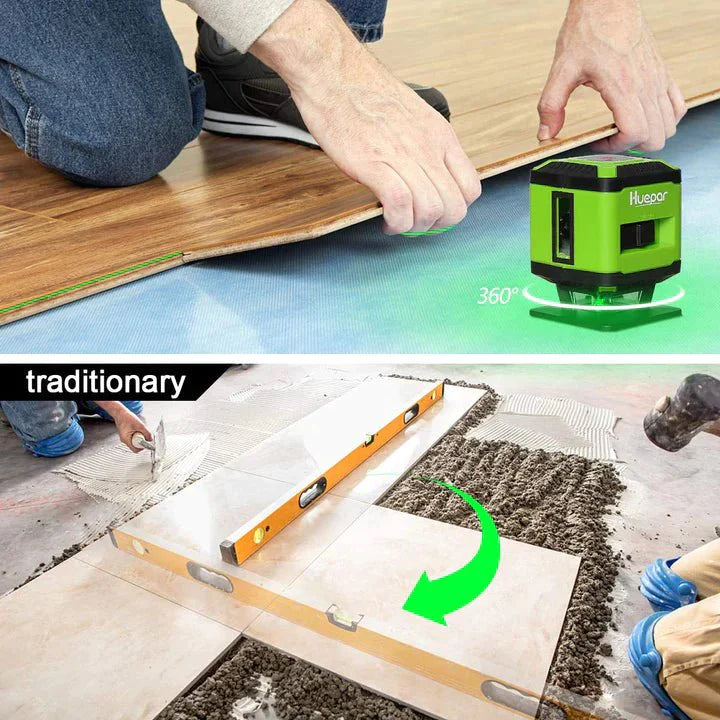Understanding 3D Laser Levels
What Are 3D Laser Levels?
3d laser levels are advanced tools for precise alignment. They project beams in three dimensions. This allows you to work on horizontal, vertical, and square layouts without moving the tool. These levels are a key part of modern construction and DIY projects. They ensure your work is level, plumb, and consistently aligned. In short, 3D laser levels are essential for accuracy in complex tasks.

How Do 3D Laser Levels Work?
3d laser levels project lines along three planes: horizontally and two vertical ones. They create a full 360-degree layout, allowing you to work around the entire room without moving the tool. This is achieved using a combination of diodes and mirrors inside the device. The diodes emit laser beams which the mirrors then direct along the desired planes. Some models come with self-leveling features. They detect and auto-correct any tilt from level within a certain range. This ensures high accuracy for projects like tiling, framing, or installing cabinets.
Advantages of Using 3D Laser Levels
When it comes to accuracy and efficiency in leveling tasks, 3d laser levels stand out. Here are key advantages:
- Multidimensional Accuracy: They create 360-degree lines on all three axes. This allows for simultaneous horizontal and vertical alignment.
- Time-Saving: You don't need to reposition the tool repeatedly, which saves valuable time on a job site.
- Ease of Use: 3D laser levels often come with user-friendly features. They can have magnetic brackets and fine-tuning knobs.
- Versatility: These tools are suitable for indoor and outdoor use. They can work for hanging wallpapers, tiling floors, or even complex tasks like surveying.
- Enhanced Visibility: Many 3D laser levels have highly visible beams. Some even offer different color choices for better visibility in various light conditions.
Incorporating a 3D laser level in your toolkit can lead to precise results. It's a boon for both DIY enthusiasts and construction professionals.
Cross Line Laser Level vs. 3D Laser Level
What Is a Cross Line Laser Level?
A Cross Line Laser Level is a type of leveling tool. It projects vertical and horizontal laser lines onto a surface. This helps in aligning and placing things with precision. It is often used in building, decorating, and DIY tasks. These levels are handy for setting up wallpapers, tiles, and more. They make sure lines are straight and meet at the right angles. Simple and easy to use, they are a favorite choice for quick jobs.
Differences Between Cross Line and 3D Laser Levels
When comparing cross line and 3d laser levels, there are key differences to note. A cross line laser emits two lines, forming a cross on a surface. 3D laser levels project lines on all sides, creating a full layout. In essence, cross lines are simpler, used for basic tasks like hanging pictures. 3D levels are more advanced, ideal for complex projects requiring precise measurements in multiple planes. While cross line lasers work well for a single wall, 3D lasers handle room-sized tasks efficiently. Always consider the project size and complexity when choosing between them.
Choosing the Right Laser Level for Your Project
Choosing the right laser level for your project depends on various factors. Consider the task's complexity, the precision required, and the environment where you'll work. For simple, indoor tasks like hanging pictures or installing shelves, a cross line laser level might suffice. Its straightforward lines are ideal for basic alignments. Conversely, if your project involves detailed constructions or outdoor sites, a 3D laser level offers more utility. This type offers full-room coverage, making large-scale tasks easier. Remember to also weigh in factors like budget, frequency of use, and whether digital features would benefit your workflow.
Advancements in Laser Level Technology
What Are 4D Laser Levels?
4D laser levels represent the next step in laser leveling technology. Unlike their predecessors, 4D models offer full 360-degree coverage, creating a three-dimensional grid of laser lines in every direction. This means improved accuracy and efficiency for tasks that need complex spatial measurements. They are perfect for jobs that need precise alignments from floor to ceiling and wall to wall. With 4D laser levels, users can expect a higher level of control and faster setup times, making them a valuable tool for both professional and DIY projects.
Benefits of 4D Laser Levels Over 3D Models
4D laser levels offer several benefits over their 3D counterparts:
- Greater Accuracy: They provide enhanced precision, crucial for complex projects.
- Full Room Layout: With 360-degree coverage, they can project lines on all walls, floors, and ceilings at once.
- Ease of Use: Improved user interfaces make them simpler to operate.
- Advanced Features: They often include features like Bluetooth connectivity, allowing for remote control and data transfer.
- Better Efficiency: By reducing setup time and the need for multiple tools, they streamline workflows.
Future of Laser Levels in Construction and DIY
The future of laser levels is promising in construction and DIY. These tools may soon have AI. AI can help adjust lines for precision. They could also connect to apps. This would make it easy to control the tool from far. Batteries may last longer too. This would make work easier and faster. With tech growing fast, laser levels will keep getting better. They will be a key tool for builders and home users alike.




